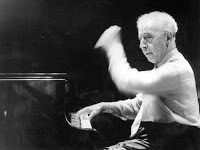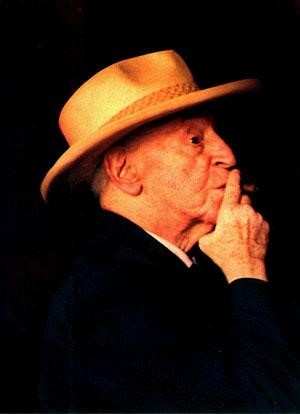Arthur Rubinstein
While Rachmaninoff was Horowitz’ opposite twin, Rubinstein was his nemesis. Two artists could hardly be so different, yet so alike. Reminds me of a story about two composers. Copland, asked about his relationship to Gershwin while both were residing in Hollywood, replied, “Well, you know, we simply had nothing in common.”
There’s such a full-bodied lilt to Rubinstein’s playing, an inner joie-de-vivre and a constant risk-taking. But he wasn’t extravagant – he played in the simplest, most natural way, like a man who strides, arms swinging, taking in the scenery and never looking at the ground at his feet. There’s an unlikely resemblance to Toscanini’s conducting technique – both possess swing and lilt and naturalness and rightness and simplicity and absolute beauty of form, all coming from a constant contact with nature. They both harness the natural weight and swing of gravity and the innate life of the human spirit, spinning them into upward, forward-moving energy.
Rubinstein was for me the ONLY pianist from age 10 to about 18. Reading his memoirs at the age of fourteen and fifteen affected me greatly in other ways as well. I wanted to possess languages and cultures like he did, so I started tackling one language after another, with the same stubborn passion that I applied to piano. I longed to enter his turn-of-the century Parisian reality. And I longed to speak a pianistic language that communicated to thousands at a time.
Chopin was my vessel to understand Rubinstein and Rubinstein my vessel to understand Chopin. His is not a fragile or sentimental Chopin – it’s strong and full-bodied. Inspired by his outdoors approach to music-making and piano-playing, I hesitated using my fingers to initiated sound; I used them as instruments of my forearms. It wasn’t until my later teenage years that I began to really learn to use my fingers. I was a full-armed pianist most comfortable in big, chordal textures.
Rubinstein recognized beautiful tone in others (especially Rachmaninoff’s “golden” tone) and possessed a natural, beautiful sound (with a soft wooden underpinning). But tonal beauty was not a goal in itself. He set his sights on the breath, the long phrase, the timing, the rubato, the vitality of the inner rhythms, and most importantly, perhaps, the larger architecture. Sound was something that came of its own and he was ever prepared to sacrifice tonal color or even risk missing the notes themselves for the sake of larger, greater goals. This element of constant risk of the small details lends his pacing and vision the quality of a great conductor. He played like an orchestra under the baton of a great conductor and breathed like a great singer.
The simplicity of his approach is ever-inspiring. Barenboim said, He seems to sift everything through a strainer and only retain what he feels to be absolutely natural and unaffected. But it’s not as dry as Richter’s approach – there’s a constant inner rubato and a stamping of every note with his personality and will. It’s a conceptual difference between the two, but it comes across. { I’ve always felt that Richter’s belief of being able to put the composer in the fore and negate his own personality belied an enormous ego or less-than-balanced mind. Richter’s black-and-white, it-just-is approach has its own deep beauty, but that’s for a later Essay . . . }
It must be admitted: Rubinstein is not generally a master of shading, and pedaling is not his forte. He always seems to choose the most direct path; he lacks something of Horowitz’ dark magic, unexpected twists, occasional melancholy or twisted passion. But who plays with such aplomb or joie-de-vivre? What the two share is a characteristic of most great pianists – in the moment of performance, their mind and heart are cleanly focused on bringing the forefront to life. They engage the audience directly and vocally, and that’s the key to heartfelt, moving, meaningful performance.
Rubinstein seems to be most in his element in rhythmically accented music. His accents are full-bodied and life-giving. His deFalla and Spanish music in general is strong for this reason. Chordal, orchestral music also suits him, Brahms for instance, or Debussy’s Engulfed Cathedral, Franck’s Prelude, Choral and Fugue, Bach-Busoni’s Chaconne. And I can just now hear him playing the solo piano version of Prokofiev’s Love of Three Oranges – TRULY orchestral!!
What interpretations does he own? Obviously, everything he touched turned to Rubinstein, which is easily distinguishable. But there are few interpretations that I would rate as the greatest of any given work. Perhaps deFalla’s Fire Dance? Or Debussy’s Engulfed Cathedral?
The other day I re-listened to his Valses Nobles et sentimentales – not his most convincing interpretation. He simply recorded too much! His enormous repertoire and appetite to learn is an inspiration in itself, but he might have been more selective. Sometimes you feel like he ought to have gone home, practiced a few more days, then come back to the studios. It’s the inner levels that are often neglected – the background finger-work. Not because his fingers didn’t work splendidly and subtly { as it sometimes seems. . . }, but because in the moment, he wasn’t focused on the inner levels and hadn’t practiced them enough at home for them to come out on their own, peripherally.
Technically, Rubinstein’s is an active forearm and upper arm technique. Imitating him feels a bit like playing tennis – his full-armed piano is so big already that when you get into forte, it quickly becomes full-contact. The fingers at first are shocked, even in piano, by the weight and speed of the attack from the forearm. They struggle to hold up. But gradually they get used to being walked upon and it becomes completely natural and effortless – and what power!!
He would often attack the keys from a foot or more in the air, enthralling audience with his balletic grace and athletic prowess. He admitted though, The real attack comes from closer to the key – the rest is just for show. And he loved to show.
He is remembered and loved almost more for what he represented as a person than for his transcendental pianism. How many great musicians can you say that about?


